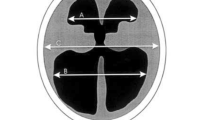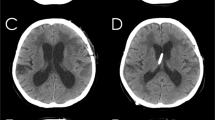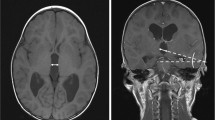Abstract
Introduction
To estimate intracranial volume-buffering capacity in the event of shunt occlusion, the reexpandabilty of the lateral ventricles and clinical manifestations were examined in shunt-dependent hydrocephalic children.
Material and methods
This retrospective study was performed in 38 children who displayed acute deterioration due to spontaneous shunt obstruction. At the time of shunt obstruction, patients with small lateral ventricles [small ventricle (SV) group: Evans' index ≤35, n=13] showed significantly more rapid deterioration into lethargy after onset than those with large lateral ventricles [lateral ventricle (LV) group: Evans' index >0.35, n=25]. All patients in the SV group were 3 years or older at the time of shunt obstruction or had a long period (5.2 years) between initial shunting and shunt occlusion. Their Evans' index was less than 0.33 prior to shunt obstruction.
Conclusions
While a shunt is functioning, the factors predictive of reduced ventricular reexpandability include (1) a lateral ventricular size smaller than 0.33 on the Evans' index and (2) either an age of more than 3 years in children who have undergone initial shunting at less than 1 year of age or over 5 years of the period after initial shunting.

Similar content being viewed by others
References
Barnes NP, Jones SJ, Hayward RD, Harkness WJ, Thompson D (2002) Ventriculoperitoneal shunt block: what are the best predictive clinical indicators? Arch Dis Child 87:198–201
Di Rocco C (1994) Is the slit ventricle syndrome always a slit ventricle syndrome? Childs Nerv Syst 10:49–58
Engel ME, Carmel PW, Choutorian AM (1979) Increased intraventricular pressure without ventriculomegaly in children with shunts: “normal volume” hydrocephalus. Neurosurgery 5:549–522
Epstein FJ, Fleischer AS, Hockwald GM, Ransohoff J (1974) Subtemporal craniectomy for recurrent shunt obstruction secondary to small ventricles. J Neurosurg 41:29–31
Holness RO, Hoffman HJ, Hendrick EB (1979) Subtemporal decompression for the slit-ventricle syndrome after shunting in hydrocephalic children. Childs Brain 5:137–144
Hyde-Rowan MD, Rekate HL, Nulsen FE (1982) Reexpansion of previously collapsed ventricles: the slit ventricle syndrome. J Neurosurg 56:536–539
Iskandar BJ, McLaughlin C, Mapstone TB, Grabb PA, Oakes WJ (1998) Pitfalls in the diagnosis of ventricular shunt dysfunction: radiology reports and ventricular size. Pediatrics 101:1031–1036
MacLaurin RL, Olivi A (1987) Slit-ventricle syndrome: review of 15 cases. Pediatr Neurosci 13:118–124
Miyao M, Ishitsu T, Maruyama H, Fukuyama Y (1978) Changes in measurements during aging determined by computed tomography (in Japanese). Brain Dev (Domestic edition) 10:459–464
Oi S, Matsumoto S (1987) Infantile hydrocephalus and the slit ventricle syndrome in early infancy. Childs Nerv Syst 3:145–150
Pedersen H, Gyldensted M, Gyldensted C (1979) Measurement of the normal ventricular system and supratentorial subarachnoid space in children with computed tomography. Neuroradiology 17:231–237
Portnoy HD, Schutte RR, Fox JL, Crissant PD, Tripp L (1973) Antisiphon and reversible occlusion valves for shunting in hydrocephalus and preventing post-shunt subdural hematomas. J Neurosurg 38:729–738
Pudenz RH, Foltz EL (1991) Hydrocephalus. Overdrainage by ventricular shunts. A review and recommendations. Surg Neurol 35:200–212
Rekate HL (1993) Classification of slit-ventricle syndromes using intracranial pressure monitoring. Pediatr Neurosurg 19:15–20
Sakamoto H, Sumimoto T, Hayashi H, Iwai Y, Tanaka K, Nishimura S (1991) Shunt nephritis associated with slit-like ventricle: a case report (in Japanese). Nerv Syst Child 16:123–128
Sakamoto H, Fujitani K, Kitano S, Murata K, Hakuba A (1994) A cerebrospinal fluid edema associated with shunt obstruction. J Neurosurg 81:179–183
Salmon JH (1978) The collapsed ventricle: management and prevention. Surg Neurol 9:349–352
Serlo W, Heikkinen E, Saukkonen AL, von Wendt L (1985) Classification and management of the slit ventricle syndrome. Childs Nerv Syst 1:194–199
Shapiro K, Fried A (1986) Pressure–volume relationship in shunt-dependent childhood hydrocephalus. J Neurosurg 64:390–396
Author information
Authors and Affiliations
Corresponding author
Rights and permissions
About this article
Cite this article
Sakamoto, H., Kitano, S. Reexpandability of the ventricular system of hydrocephalic children in the event of shunt occlusion. Childs Nerv Syst 22, 517–522 (2006). https://doi.org/10.1007/s00381-005-0015-1
Received:
Published:
Issue Date:
DOI: https://doi.org/10.1007/s00381-005-0015-1




